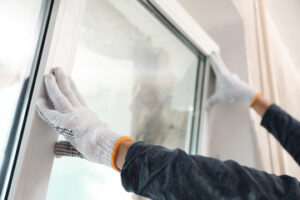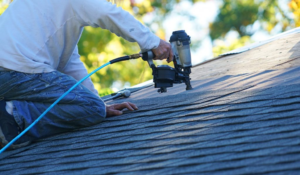When you replace your old windows, you will experience benefits beyond the natural light and refreshed look. You’ll also enjoy better functionality and increased curb appeal.

Energy-efficient replacement windows help keep the interior temperature stable, improving air quality. They can also reduce outside noises like traffic, construction, and airplanes, creating a quieter indoor environment.
Having energy efficient windows is a great way to reduce your home’s carbon footprint. In addition, they’ll help you save money on your energy bills and can add value to your home when it’s time to sell.
New replacement windows are a great solution for your energy efficiency needs because they create a tight seal around the window and prevent air infiltration. As a result, your heating and cooling systems won’t have to work as hard to keep your home at a comfortable temperature.
The insulated frames and gas fills in modern replacement windows also minimize the transfer of heat from inside to outside. As a result, you’ll notice less of a difference between the temperature in different rooms of your house.
You’ll also find that your furniture, carpeting and window treatments will last longer because they won’t fade from excessive exposure to sunlight. This is because modern windows are able to block out up to 95% of harmful UV rays.
Another benefit of upgrading your windows is the improved visibility you’ll experience. Older windows often become hazy or discolored over time, which can make your home feel dark and uninviting. New replacement windows are available in a variety of glass options to brighten and open your space.
There’s also an increased focus on sustainability, which means more homeowners are opting for energy-efficient replacement windows. As a result, you’ll find that your energy costs will decrease, and your home will be more comfortable and inviting.
Homeowners are increasingly looking for ways to improve their home’s comfort and energy efficiency, while increasing its resale value. Replacing your outdated windows with new replacement windows is one of the most cost-effective and convenient upgrades you can make. With so many options on the market, you’ll be sure to find replacement windows that fit your style preferences, budget and lifestyle. Aside from being aesthetically pleasing, new windows are easier to open, close and clean than older versions. Moreover, they come in a wide array of finishes and styles that can complement any architectural design.
Increased Home Value
New windows are one of the most cost-effective home renovations that you can make. When combined with energy savings, you can realize up to an 80% return on investment when it comes time to sell your home.
The type of window replacement that you choose will have a significant impact on your home’s value. If you are replacing old windows in an older home, full frame replacement windows are a better option since they allow you to keep the original frame and trim, which will add to your home’s character and history. In addition, full frame replacement windows are more secure than insert replacement windows because they have nail fins that securely attach to the studs of the existing wall.
Insert replacement windows, on the other hand, are a good choice if you want to replace your existing windows but don’t want to disturb the existing trim or siding. With this type of replacement, the old sashes and frame are removed but the original frame is kept in place and the new window slides into it like a puzzle piece. This type of replacement also allows for a faster installation and typically is less expensive than a full-frame replacement.
Another type of replacement window is a block frame window, which is similar to full-frame replacement windows but without the nail fins. Block frame windows are often used in historic homes or in cases where the original window frames are rotting.
If you are building a new home, new construction windows will be the best option. These are installed during the framing stage before any trim or siding is added and they have standardized sizes, making them easier to find at large home centers and construction suppliers. New construction windows also have nailing fins that secure the windows to the studs of the house, which is necessary in areas where there is a lot of movement or expansion and contraction of the walls.
If you are remodeling an existing home, replacement windows will be the most cost-effective and least disruptive option. New construction windows require major alterations to your wall systems, trim and siding which can be costly and messy. This is not a problem for newer homes, but is something to consider if you are living in a historical home with carefully curated trim and siding that you don’t want to disrupt.
Increased Comfort
If you’re tired of feeling drafty in your home during winter or dealing with sweltering summer heat, it may be time to invest in replacement windows. Today’s advanced designs and materials are engineered to prevent energy loss, enhancing comfort levels all year round. In addition, many new windows feature improved ventilation capabilities that help maintain fresh indoor air quality and reduce moisture, reducing the risk of mold and mildew.
Moreover, modern replacement windows are designed with advanced sound-blocking features that create a quiet and peaceful living space. This is a major benefit for families and people with sensitive hearing or who live in noisy neighborhoods. Older windows are often poor insulators, allowing sounds to travel easily from one room to another.
Another major benefit of modern replacement windows is their easy-to-clean design. Many models come with built-in self-cleaning glass that eliminates the need for manual washing and helps protect your investment. Additionally, the frames are coated with a protective sealant that helps preserve their appearance and performance over time.
Lastly, by boosting your home’s energy efficiency, you’ll be doing your part to help combat climate change and support sustainable living. This green investment can also increase your home’s resale value, allowing you to get a higher return on your investment should you decide to sell your property in the future. Potential buyers will be attracted to a home that’s efficient, comfortable, and environmentally friendly. With more and more homebuyers looking for energy-efficient properties, upgrading your home with modern replacement windows is a smart strategy for improving its appeal on the market.
Increased Curb Appeal
Whether you’re planning to stay in your home forever or selling it, it pays to take care of your property’s curb appeal. It’s the first impression potential buyers have, and a dingy facade can turn them off before they ever step inside. Fortunately, there are plenty of budget-friendly ways to boost your home’s curb appeal. From adding a seating area to painting your mailbox, these upgrades are easy enough for anyone to do in a day, week or month while still staying on a budget.
The right windows make an immediate impact on your home’s exterior. New high-efficiency windows are available in a wide range of styles and materials to complement any home’s architectural style, from wood-clad vinyl to steel-clad aluminum. Many manufacturers offer windows in both full frame replacement and insert window installation options. Full frame windows have an attached frame, while pocket replacement windows fit within the existing sash and trim. If you have stucco siding, choose a flush fin window to avoid damaging the exterior cladding.
New shutters and trim add a fresh, inviting look to the exterior of your home. These simple accents can give the appearance of an entire renovation job and are often less expensive than full-scale exterior remodeling. Plus, they’re easier to maintain than traditional shingle siding.
A dingy front door can detract from your home’s overall appeal, so consider replacing your entry door with a more eye-catching model. There are a variety of doors to choose from, including steel entry doors with glass panels, fiberglass front doors and storm doors made of copper or iron. Some models even allow you to customize the hardware and hardware finishes for a personalized look.
Easily improve your home’s curb appeal by relocating eyesores, like utility boxes and power lines, or planting a flowering vine to cover an unsightly AC unit. Also, consider installing lighting to showcase the house and landscaping at night. This is a great way to add curb appeal on gloomy days or if potential buyers drive by after dark. You can find a wide variety of lights and fixtures online, as well as DIY trellis kits or prefabricated sections that can be built on your own.

